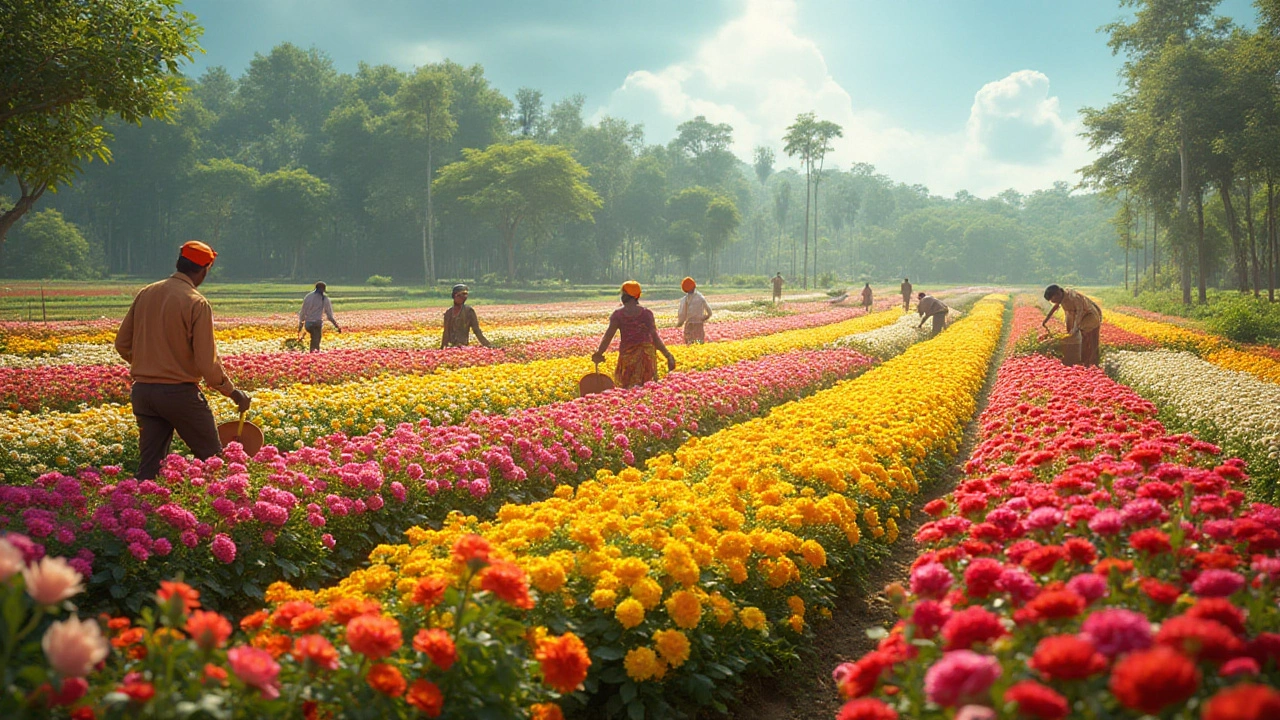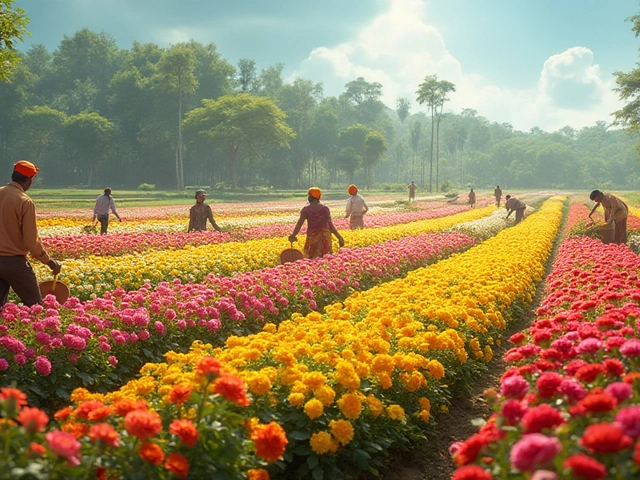India, with its rich agricultural heritage and diverse ecosystems, has emerged as a significant player in the global flower market. While several states engage in floriculture, one state stands out as the top exporter of flowers. Understanding which state leads in flower exports not only sheds light on the economic dynamics but also offers inspiration for budding gardeners. Whether you're involved in flower gardening or simply cherish the beauty of flora, knowing where these blooms predominantly come from can deepen your appreciation for their journey.
In this article, we explore the factors that contribute to one state's supremacy in flower exports. From the varieties that flourish in its soil to the modern techniques employed in their cultivation, we offer an insight into what makes this region a powerhouse in the floricultural industry. Additionally, for those keen on flower gardening, we provide practical tips to align your practices with those of export-quality flower growers.
- Introduction to India's Floriculture
- Top Flower Exporting State
- Popular Flowers in the State
- Tips for Growing Export-Quality Flowers
Introduction to India's Floriculture
India's floriculture industry has blossomed into a vibrant sector, thanks to the lush landscapes and varied climates that the country boasts. With regions that experience everything from tropical to temperate weather, India is a fertile ground for a diverse array of flowers. These conditions, coupled with the expertise passed down through generations, have made India a rising star in the global floriculture scene. As the demand for flowers continues to bloom, Indian states have geared up to leverage their unique climates to cultivate blooms that cater to domestic and international markets alike. From the majestic fields of roses in Maharashtra to the exotic orchids of Sikkim, each state has carved its niche in the vast expanse of India's flower industry.
Historically, floriculture in India has transcended mere aesthetics. The country houses a rich tapestry of traditions in which flowers play a pivotal role, both religiously and culturally. Festivals, weddings, and rituals are incomplete without the fragrant presence of blooms such as marigolds, jasmine, and roses. Yet, it wasn't until the late 20th century that India recognized the potential of floriculture as a substantial economic venture. Since then, the industry has witnessed a paradigm shift. Rapid advancements in technology, transportation, and cultivation practices have propelled Indian flowers to international acclaim, making them a staple in flower markets worldwide.
The economic footprint of floriculture is impressive. It not only contributes significantly to the livelihoods of thousands of farmers but also generates foreign exchange on a large scale. According to data from the Agricultural and Processed Food Products Export Development Authority (APEDA), India's flower exports have shown consistent growth in the past decade. A remarkable collection of blooms like gladioli, carnations, anthuriums, and heliconias have found their place in the global boulevards. The sector is poised for further growth, with the government and private stakeholders joining hands to enhance the infrastructure, quality, and logistics necessary for reaching the zenith of success. It's a colorful revolution that paints a promising picture for the Indian economy.
The challenges are multi-fold, though. Small and marginal farmers often lack the resources to adapt to new technologies or mitigate the adverse impacts of climate change. However, initiatives aimed at skill development and financial assistance have started bridging these gaps. The government is keenly aware of floriculture's untapped potential and has been taking measures to provide better irrigation facilities, cold storage chains, and market access. Collaborations with international horticulture experts have also been instrumental in introducing hybrid varieties and sustainable practices. This collaborative work is a testament to the resilience and adaptability of Indian agriculturists.
"India's floriculture is not just an industry; it's the heart of our cultural expression and rural economy," notes Dr. R.K. Pachauri, a well-respected environmentalist. His words underline the multidimensional impact flowers have on Indian society. Growing flowers isn't merely about business; it's about nurturing a legacy of beauty that stands as a symbol of resilience and hope.
The future of Indian floriculture appears as captivating as the blooms it produces. The potential is as vast as the geographical expanse of the country. Market experts predict a surge in floriculture exports, with projections hinting at doubling figures over the next five years. As the global community embraces sustainable practices, India is poised to lead with its eco-friendly and economically viable flower production. For those involved or keenly interested in flower gardening, India presents a landscape as rich as its vibrant flowers, brimming with opportunities to cultivate and celebrate natural beauty.
Top Flower Exporting State
In the diverse and vibrant landscape of India, it's Karnataka that takes the crown as the largest flower exporter. Situated in the southwestern part of the country, Karnataka's favorable climate, fertile soil, and a rich tradition of horticulture make it an ideal ground for cultivating a variety of blooms destined for markets worldwide. With leading cities like Bengaluru and surrounding areas at its core, the floriculture in this state is more than just an agricultural activity—it's an art form that brings together centuries of knowledge with modern practices.
What sets Karnataka apart in terms of flower export is its commitment to quality and diversity. From marigolds and roses to exotic orchids and temperate blooms, the state has carved a niche for itself through both commonplace and rare varieties. The state's authorities have actively supported floriculturists by providing infrastructure such as cold storage facilities, better transportation, and access to international markets. The consistency in quality, aided by scientific farming techniques and government initiatives, ensures that Karnataka's flowers meet the global standards demanded by international buyers.
Karnataka's success story in flower export isn't just about the climate and soil. It's heavily attributed to the innovative approaches that farmers here adopt. Micro-irrigation techniques, nutrient management through soil testing, and pest control using organic methods are just some of the modern practices that reflect the ongoing evolution in this sector. Many farmers believe that adapting these techniques is key to staying competitive on a global scale. Indeed, agriculture experts from the University of Agricultural Sciences in Bengaluru often highlight Karnataka as a "model of sustainable floriculture," proving that innovation and tradition can walk hand-in-hand.
The impact of Karnataka's leadership in flower exports reverberates throughout its economy. Thousands of small and medium-sized farmers depend on floriculture for their livelihoods, and the sector provides employment opportunities for women, especially in rural areas. This empowerment through participation in the flower trade contributes not just to economic prosperity but also to social upliftment. With export profits reinvested into community development projects, the effect of this thriving industry extends well beyond simple sales and profits.
The strategic location of Karnataka also plays a notable role in its export capabilities. Its accessibility to major ports such as the ones in Chennai and Mangalore facilitates efficient shipments to international markets in Europe, the Middle East, and Asia. Market alliances and trade partnerships are increasingly focusing on these regions, ensuring that the global demand for Indian blooms remains robust.
"Karnataka's strength in floriculture is a beacon for other states aiming to make a mark in the agrarian export landscape," points out Dr. Meenakshi Rao, a leading agricultural economist.
To paint a picture with numbers, the total area under flower cultivation in Karnataka is steadily increasing; statistics from agricultural reports suggest the area might have expanded by 5% annually in recent years, indicating strong growth prospects. This is manifest in the accompanying data that shows rising export values each year. Such data serve as a testament to the relentless dedication of the state’s floriculturists who continue to enrich Karnataka's reputation as India's floral crown. As significant as these numbers are, the human stories behind them are equally enchanting, showcasing tradition, unity, and a shared commitment to quality.

Popular Flowers in the State
Nestled in a region blessed with fertile soil and favorable climate, India's largest flower-exporting state proudly showcases an array of blooms that captivate both local and international markets. Among these, the fragrance of roses fills the air, commanding attention with its classic elegance and perennial beauty. Roses, known for their durability and versatility, are cultivated extensively here, making their way into bouquets and floral arrangements worldwide. The state's proximity to conducive natural resources paves the way for an array of rose species, each distinguished by color, dimension, and fragrance, catering to diverse global demands.
Another remarkable flower deeply rooted in this landscape is the exotic marigold. Revered for its vivid hues ranging from golden yellows to fiery oranges, marigolds are a staple in Indian festivities. They're also favored for garlands and ceremonial decorations, bridging tradition with modern use in social functions. The state's cutting-edge agricultural practices ensure marigolds bloom robustly, handling domestic distribution with ease while meeting export needs. Marigolds' resilience against pests and diseases, coupled with their adaptability to varying climates, positions them as an ideal choice for floriculture enthusiasts looking to cultivate and grow.
The gerbera daisy, with its vibrant display of colors, from bright oranges to gentle pinks and brilliant whites, joins the lineup. As a symbol of cheerfulness, gerberas have an undeniable appeal, finding their way into celebratory arrangements and everyday bouquets. Thanks to the state's innovative growing techniques, gerberas thrive throughout the year, offering consistent quality and quantity to meet international demands. Such relentless agricultural advancements make the state a frontrunner in delivering quality floricultural products, sustaining its leadership in the global arena.
Sunflowers, with their radiant faces turning towards the sun, are also key players in the state's floral tapestry. They harbor not just aesthetic appeal but also economic value, making them a favorite among organic product creators who harness their seeds for oil production. In our quest to uncover the essence of the state's floricultural success, let us quote a local horticulturist who aptly describes the synergy between nature and nurture:
"Nature provides the canvas, we simply ensure the paint adheres."Such harmony within agricultural circles propels the state's reputation as an exceptional flower exporter.
For those interested in the more unusual blooms the state has to offer, the bird of paradise offers a quirk of nature. With its striking resemblance to a brightly colored bird, it sparks curiosity with its bold blues and striking oranges, making it a highly desired addition to exotic bouquets. Despite its exotic appeal, the bird of paradise thrives in the state's climate, benefiting from the careful balance of nature and science that local farmers have mastered over the years.
Tips for Growing Export-Quality Flowers
Delving into the realm of growing export-quality flowers can be both a rewarding and challenging experience for any gardener. Achieving the high standards required for international markets demands meticulous attention to various factors, including soil quality, climate compatibility, and pest management. First and foremost, understanding the local climate and selecting flower varieties that naturally thrive in these conditions is key. For instance, lilies and roses are particularly popular in India, beloved for their vibrant colors and lasting freshness. While the natural environment plays a crucial role, it's equally important to simulate ideal growing conditions artificially when necessary. This involves controlling humidity and temperature within greenhouses to match the specific needs of each flower species.
Attention to soil composition can greatly influence the quality of the blooms. A well-draining, nutrient-rich soil amended with organic compost ensures robust growth and bountiful flowering. Regular soil testing, perhaps every few months, helps in adjusting the pH and nutrient levels to maintain optimal growing conditions. This proactive approach paves the way for producing consistently high-grade flowers. Watering schedules are another critical consideration. Ensuring a consistent moisture level without waterlogging is crucial. Drip irrigation systems are highly recommended, as they efficiently manage water supply, preventing both over and under-watering scenarios. Additionally, practice regular pruning techniques to enhance airflow among plants, preventing disease spread and encouraging fuller growth.
As noted by horticulturist Dr. Anita Desai, "The secret to floriculture success lies in treating each plant as an individual, understanding its unique requirements and adapting your care to match those needs."
Pest and disease management cannot be overlooked. Traditional and organic pest control methods should be employed, depending on the flower species and market requirements. Biological control methods can be particularly effective, promoting a sustainable ecosystem within flower farms. Companion planting, an approach replete with benefits, not only aids in deterring pests but also helps in enriching the soil naturally. This technique involves growing different plants close to each other, creating a habitat for beneficial insects and enhancing biodiversity.
Lastly, it's important to integrate modern technology for tracking and maintaining quality standards. Utilizing agricultural apps for monitoring growth conditions offers precision and ease, allowing timely interventions when anomalies are detected. By compiling data and maintaining records, growers can continuously refine their methods and processes. Remember, cultivating flowers for export requires a combination of science, art, and a touch of tenderness. While the path may seem complex, each successful bloom and delighted customer provides affirmation of your efforts.



